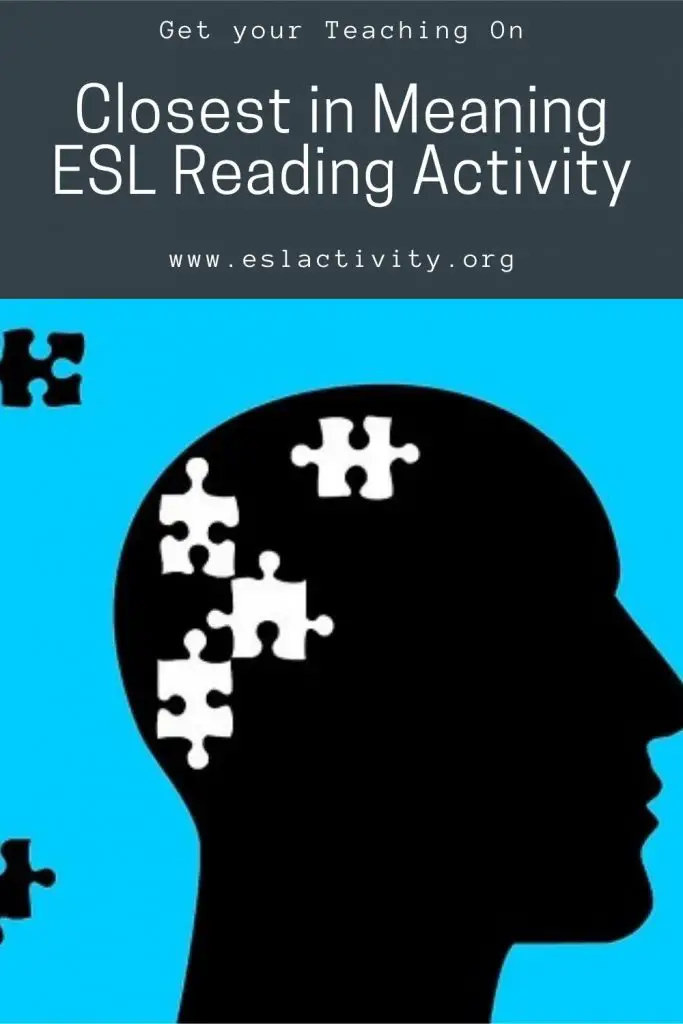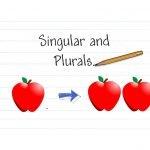If you’re looking for a simple reading activity that helps students with inferring the meaning of something from the context, then you’ll want to check out closest in meaning. It’s ideal for any age and almost all levels of students so give it a try today!

Closest in meaning
Closest in Meaning Reading Activity
Skill: Reading
Reading Sub-Skills: Inferring meaning from context
Time: 10 minutes
Level: Intermediate-advanced
Materials Required: Sentences with corresponding match options
It’s often the case when reading anything in a language that we’re not fluent in to encounter words we don’t know. Some people reach for their dictionary every single time this happens but this isn’t necessary and it’s certainly not efficient. Of course, having a solid knowledge of discourse features is a great help in this.
Instead, a more effective way is to guess the meaning of the unknown word using context clues. This activity is designed to help our students with this important skill.
Make some sentences and for each one, have 2-3 corresponding sentences, one of which is obviously closest in meaning to the original than the other ones. I use a slightly higher level of vocabulary than the students are at and don’t allow them to use their dictionaries.
Closest in Meaning Example
For example:
Focus: The professor delivered her lecture eloquently.
Answer: The professor’s lesson was clear and easy to understand.
Extra Sentence 1: The professor’s lecture was presented in a PowerPoint.
Extra Sentence 2: The professor’s class was spoken too quickly.
You may want to have students work together in pairs to complete this activity, or at the very least, compare with a partner when they’re done. After this, check the answers together as a class.
Another thing that I’ll often use this activity for is adverbs of frequency. It’s the perfect way to find out whether or not students truly understand the meaning. More details here: Frequency Adverbs Activities.
Procedure for Closest in Meaning:
- In advance, write some sentences and some corresponding sentences. One should be closer in meaning to the original than the others and use some higher-level vocabulary throughout.
- Students have to choose the sentence that is closest in meaning to the original using context clues, alone or in pairs.
- If done alone, students can compare answers with a partner.
- Check answers as a class and discuss helpful context clues used in the activity.
Did you like Closest in Meaning?
Yes? Thought so. Then you’re going to love this book over on Amazon: ESL Reading Activities for Teenagers and Adults. The key to better English classes is a variety of interesting and engaging TEFL activities and this book will help you get there in style.
You can find the book in both digital and print formats. Consider keeping a copy on the bookshelf in your office to use as a handy reference guide. Or, take the e-version with you to your favourite coffee shop for some serious lesson planning on the go.
Whatever the case, you’re going to have better ESL reading classes! And, Closest in Meaning is just one of the dozens of activities in this book. Pick up a copy today:
FAQS
What is the “closest in meaning” ESL activity? A: The “closest in meaning” activity is an exercise where learners are given a word or phrase, and they need to choose the option that has the closest meaning among a set of provided choices.
What is the purpose of the “closest in meaning” activity?
The activity aims to enhance learners’ vocabulary and understanding of word nuances by challenging them to identify the most appropriate synonym or closely related term for a given word or phrase.
How can I conduct the “closest in meaning” activity?
Provide learners with a list of words or phrases and a set of options for each. Instruct them to select the option that has the closest meaning to the given word or phrase. This can be done as a written exercise or through interactive activities and games.
What are the benefits of the “closest in meaning” activity?
This activity helps learners expand their vocabulary, improve their understanding of word usage, and develop their ability to choose the most appropriate word or phrase in context. It also promotes critical thinking and analytical skills.
How can I create “closest in meaning” questions?
Select target words or phrases that are relevant to your learners’ language proficiency level. Provide a list of possible options, ensuring that one choice is the closest in meaning. Consider using synonyms, antonyms, or words with similar connotations.
Can the “closest in meaning” activity be adapted for different proficiency levels?
Yes, you can adapt the difficulty level by selecting words or phrases that correspond to your learners’ proficiency level. For beginners, focus on simpler vocabulary, while more advanced learners can tackle more complex or nuanced terms.
How can I provide feedback in the “closest in meaning” activity?
After learners complete the activity, review the correct answers as a class or in small groups. Discuss any questions or doubts they may have had and provide explanations for the correct choices. Encourage learners to ask questions and engage in discussions about word meanings.
Have your say about this Reading for Detail Activity
What are your thoughts about closest in meaning? Have you tried it out with your students? Leave a comment below and let us know what you think. We’d love to hear from you.
Also, be sure to give this article a share on Facebook, Pinterest, or Twitter. It’ll help other busy English teachers, like yourself, find this useful resource guide.

Close in meaning
Last update on 2022-07-17 / Affiliate links / Images from Amazon Product Advertising API




